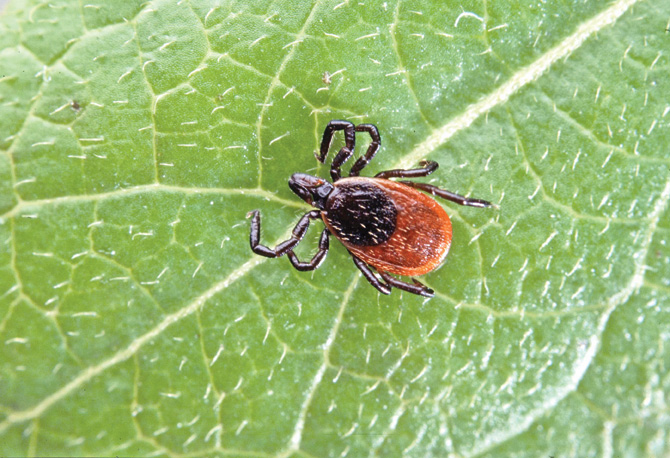Yale researchers develop Lyme disease vaccine

Clinical trials have not been done, but it does hold promise.
Researchers from Yale University have developed a messenger ribonucleic acid (mRNA) vaccine against “Borrelia burgdorferi,” commonly known as Lyme disease, according to Yale Daily News. The vaccine has been tested on guinea pigs but has not undergone clinical trials yet, so its effectiveness on humans remains uncertain.
The paper was originally published in the medical journal Science Translational Medicine on Nov. 17. The study focused on human diseases — particularly Lyme disease — from black-legged ticks, otherwise known as deer ticks. The scientific name for deer ticks is “Ixodes scapularis,” which was shortened to “I. scapularis” in the paper.
According to the paper, the hypothesis was that “acquired resistance to I. scapularis due to repeated tick exposure has the potential to prevent tick-borne infectious diseases.” One part of the tick that is thought to contribute to the disease delivery process is salivary proteins.
The researchers analyzed the lipid nanoparticle’s ability to enhance the host body’s capability to recognize a tick bite. These lipid nanoparticles contain “nucleoside-modified mRNAs” encoded with 19 types of deer tick salivary proteins. Vaccinated guinea pigs developed erythema, a reddening of the skin from injury or irritation, on bite locations shortly after the ticks bit them. This caused the ticks to feed poorly and hindered the transmission of Lyme disease to the guinea pigs.
The usage of mRNA enveloped in lipid nanoparticles is also how the COVID-19 vaccine gives people resistance to the COVID virus, although the number of antigens targeted is different. The COVID vaccine exposes receivers to one “spike protein” through mRNA delivery, according to the Center for Disease Control and Prevention (CDC), compared to the 19 salivary proteins in the Yale mRNA vaccine.
“The effective induction of local redness early after I. scapularis attachment and the inability of the ticks to take a normal blood meal suggest that 19ISP [the salivary proteins] may be used either alone or in conjunction with traditional pathogen-based vaccines for the prevention of Lyme disease, and potentially other tick-borne infections,” the paper states. According to the Massachusetts Bureau of Infectious Disease and Laboratory Sciences, deer ticks can also spread the diseases Babesiosis, human granulocytic anaplasmosis, Borrelia miyamotoi, and Powassan virus.
Sam Telford, an epidemiologist and a professor of infectious diseases at Tufts University, told the Times the human mRNA vaccine may take five or more years to come to fruition.
“The nice thing about this mRNA approach is that it targets the tick bite in general, not the specific infectious agents. If the tick cannot feed, then it cannot transmit infection of any kind. This idea has been around for a long time, but only recently with this Yale work have we seen a glimmer of hope,” Telford said.
If Yale’s mRNA Lyme disease vaccine is successful, would it help the Island’s tick problem?
“[It’s] one small piece of the tick puzzle on the Island. There are another 10 or 11 diseases, so it’ll help to have a vaccine against Lyme, but it doesn’t help the tick problem because there are so many different diseases you can get from deer ticks and lone star ticks,” Richard Johnson, current head of the Martha’s Vineyard Tick Program, said.
Johnson said Lyme disease cases have plateaued or even gone down. Since more people are aware of Lyme disease and ticks, Johnson believes new Lyme disease cases are not a big problem. “People who got Lyme disease and didn’t get treated or got what we call ‘post-treatment Lyme,’ a lot of them are still suffering from it and we don’t understand why or what to do about it. So that’s the big issue. That’s the bigger issue now than the new cases,” he said.
However, Johnson does think the number of cases is underreported. This is because to be counted as a confirmed case, a Lyme disease patient needs to have a blood test done on them. Most Islanders get treated for symptoms rather than get tested, so the true numbers are hard to come by, according to Johnson.
Johnson said he has seen more cases of Babesiosis and spotted fever than Lyme disease in recent times. Spotted fever is spread by the bite of American dog ticks, according to the CDC.
Yale’s mRNA vaccine is not the first time a Lyme disease vaccine was developed. According to the National Center for Biotechnology Information, the only Lyme disease vaccine to be approved by the Food and Drug Administration was LYMErix in 1998, developed by GlaxoSmithKline (then known as SmithKline Beecham). The recombinant vaccine reduced new infection rates in vaccinated adults by nearly 80%. However, the manufacturer voluntarily pulled LYMErix from store shelves after only three years from a combination of fears of vaccine side-effects, a class-action lawsuit, negative media coverage, and declining sales.
“We have a perfectly good vaccine. We just can’t get it, which is a little bit maddening,” Johnson said. LYMErix’s beta testing was done on Martha’s Vineyard and those who received the vaccine say they have not had Lyme disease before, according to Johnson.
Johnson said LYMErix was similar to the Lyme disease vaccines given to pet dogs today.
The Yale mRNA vaccine is also not the only vaccine currently in development, according to ClinicalTrials.gov. VLA15, a multivalent recombinant Lyme disease vaccine developed by Valneva Austria GmbH in collaboration with Pfizer, is undergoing the second phase of its clinical trials.
Telford was a part of the research and development of LYMErix, and he said VLA15 is very similar to LYMErix in how it “generates immunity to the main outer surface protein of the bacterium that causes Lyme disease.”
“I would think that the Valneva vaccine, now planning and recruiting for a Phase III clinical trials, will demonstrate efficacy and be approved by FDA, perhaps as early as 2024,” Telford said.
“I hope they’re successful. The sooner the better, obviously,” Johnson said about the Lyme disease vaccines being developed.

